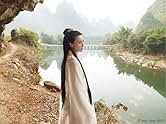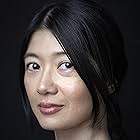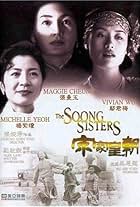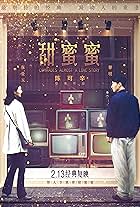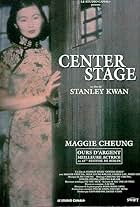Inspired by the drowning of 23 Chinese undocumented cockle pickers in Morecambe Bay (northwest England). Mazu, goddess of the sea, floats over the tragedy.Inspired by the drowning of 23 Chinese undocumented cockle pickers in Morecambe Bay (northwest England). Mazu, goddess of the sea, floats over the tragedy.Inspired by the drowning of 23 Chinese undocumented cockle pickers in Morecambe Bay (northwest England). Mazu, goddess of the sea, floats over the tragedy.
Photos
- Director
- Writers
- All cast & crew
- Production, box office & more at IMDbPro
Storyline
Featured review
I visited MoMA recently and worked my way down from the top floor to try and avoid some of the crowds (although I think everyone has this idea so maybe better to not do that?). By the time I reached the second floor where this installation was, I probably needed to leave because the same day I was going to see the Knicks play the Nets and I probably didn't have the time to watch a 55 minute film – although in hindsight it was a terrible game, even by the standards of a Knicks fan who is used to them not being any good. Anyway, I digress, but I mention this because even with the time being short, I watched this film from start to end and there was no way I was leaving before I had.
To call it a film is to do it a disservice because this is an installation and to see it any other way would make it lose some of its impact. The film is shown across 9 different double sided screens which are arranged above one large area in MoMA. Not all 9 are in use at any one time and often different images around the same scene are displayed on each one. No matter where you stand or sit, it is pretty much impossible to see all of them at the same time so you end up seeing things in a slightly different order and perspective from others in the same space. The sound from the film is played from speakers under each screen and this fills the space to draw you in to the installation. Technically it terms of design and editing it is incredibly impressive and I cannot imagine the work to put it together.
The content of the film is not a straight narrative or even close; indeed several times the film moves beyond the film and shows us the film being made, so it is a strange experience. In essence the film is inspired by the death of the Chinese cockle pickers in the UK in 2004 and it uses this as its starting point, with the emergency call being played along with later poetry which links to the death of Chinese migrants in different situations. We have shots of a female deity (played by Maggie Cheung) who protects people from the sea in the region that many of the cockle pickers came from. We also have scenes from modern China as well as calligraphy done on glass screens. Oddly we also do have as much time spent outside the film, so like I said we get to see Cheung being shot on green-screen while someone controls the wire work; we also spend as long watching 4 guys clean the painted symbols off the glass as we watched the guy create them! It is a very odd mix of things but it works incredibly well as a whole.
The spoken words are often hard to hear – not sure if this is a downside of the large space or intentional; but the poetry is sparsely used and effective while the emergency call is chilling when combined with the images from a search and rescue helicopter and the gradual introduction of Cheung, her own sad eyes searching for those in need to protection but, presumably, unable to do so for those who have migrated so far from their home. While the images and structure doesn't always make sense in a traditional application of narrative, it is beautifully shot with different angles and detail from same scenes all looking beautiful – even the rich color of the green-screen section is beautiful. Any one shot is good but to have them all together in such an installation makes them work even better.
I can't imagine it working as well on one screen showing all the images in one view, but as an installation it was really great, providing a whole experience which was immersive, moving, beautiful, confusing and creative. I could easily have stayed in that space for another viewing (and had I known how poor the Knicks would be, I would have done). Well worth taking the hour to experience if you get the chance.
To call it a film is to do it a disservice because this is an installation and to see it any other way would make it lose some of its impact. The film is shown across 9 different double sided screens which are arranged above one large area in MoMA. Not all 9 are in use at any one time and often different images around the same scene are displayed on each one. No matter where you stand or sit, it is pretty much impossible to see all of them at the same time so you end up seeing things in a slightly different order and perspective from others in the same space. The sound from the film is played from speakers under each screen and this fills the space to draw you in to the installation. Technically it terms of design and editing it is incredibly impressive and I cannot imagine the work to put it together.
The content of the film is not a straight narrative or even close; indeed several times the film moves beyond the film and shows us the film being made, so it is a strange experience. In essence the film is inspired by the death of the Chinese cockle pickers in the UK in 2004 and it uses this as its starting point, with the emergency call being played along with later poetry which links to the death of Chinese migrants in different situations. We have shots of a female deity (played by Maggie Cheung) who protects people from the sea in the region that many of the cockle pickers came from. We also have scenes from modern China as well as calligraphy done on glass screens. Oddly we also do have as much time spent outside the film, so like I said we get to see Cheung being shot on green-screen while someone controls the wire work; we also spend as long watching 4 guys clean the painted symbols off the glass as we watched the guy create them! It is a very odd mix of things but it works incredibly well as a whole.
The spoken words are often hard to hear – not sure if this is a downside of the large space or intentional; but the poetry is sparsely used and effective while the emergency call is chilling when combined with the images from a search and rescue helicopter and the gradual introduction of Cheung, her own sad eyes searching for those in need to protection but, presumably, unable to do so for those who have migrated so far from their home. While the images and structure doesn't always make sense in a traditional application of narrative, it is beautifully shot with different angles and detail from same scenes all looking beautiful – even the rich color of the green-screen section is beautiful. Any one shot is good but to have them all together in such an installation makes them work even better.
I can't imagine it working as well on one screen showing all the images in one view, but as an installation it was really great, providing a whole experience which was immersive, moving, beautiful, confusing and creative. I could easily have stayed in that space for another viewing (and had I known how poor the Knicks would be, I would have done). Well worth taking the hour to experience if you get the chance.
- bob the moo
- Jan 20, 2014
- Permalink
Details
- Runtime55 minutes
- Color
Contribute to this page
Suggest an edit or add missing content


